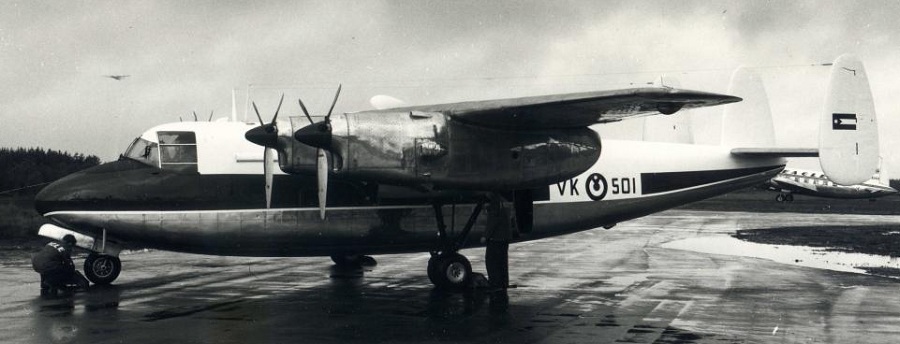

British European Airways
Almost from the point at which it was created as a requirement by the Brabazon Committee, efforts had been made to interest the airlines in the Marathon, and these proved unsuccessful until a meeting of the Interdepartmental Committee on Civil Aircraft Requirements (ICAR) in June 1946. At this meeting, the British European Airways Corporation (BEAC, and later abbreviated to BEA) agreed to take 50 of a turboprop version of the aircraft (according to a later press release, “…for use on British internal services, and for some services between provincial cities and the Continent.”). Delivery was expected to start sometime after April 1948, with order completion by March 1949. BEAC would pay approximately £40,000 per aircraft, and though the turboprop engine was not likely to be ready immediately, the Ministry of Supply was happy with this situation. It had calculated that the BEA order would offset the cost of producing 25 piston-engined Marathons for export so that immediate production could begin; by the time these Mark I aircraft had been built, the expectation was that the BEAC aircraft would be ready for manufacture and meanwhile the BEAC funding would have bankrolled the piston-engined aircraft. On 15th August 1946 the Ministry of Supply therefore sought Treasury funds of £2 million for the order of 50 Marathon II for BEA. The Treasury was in agreement, provided that BEA agreed to, "...accept delivery of the aircraft when produced, or should it by any chance be decided at a later date that the order should be cancelled, that they would meet any nugatory expenditure involved". In other words, BEA was being asked to accept financial responsibility for the aircraft, even if it received none. Therefore it came as no surprise that the airline did some hard thinking and responded on 3rd October that, due to the Marathon's poor range, it wanted its order reduced from 50 to 25 aircraft. The Treasury then began discussions with Miles, with a view to the government underwriting production of the 25 Marathon I aircraft. It was expected that BOAC would act as agents for the latter aircraft and that they would obtain quick sales for them. Funding was agreed on 17th October 1946.
Miles responded with a tender for both Marathon I and II aircraft, with the Mark I priced at £37,710, including furnishing, but not included was a £2,020 agent's commission, while the Marathon II came out at £34,710 plus a £1,860 agent's commission. Thus, the government would have a £1.07 million liability if none of the Marathon I aircraft found buyers. Miles' production estimates saw Marathon I production running from January 1948 to January 1949, with Marathon II deliveries commencing in August 1948. A Treasury response of 25th November 1946 from Mr MT Flett brought the first indications of problems with his statement that, "[Miles] have now submitted quotations which are certainly on the high side and may make purchasers unduly difficult to find." Flett went on to highlight that Miles' financial position meant that they could not really afford to accept any risk, and in this he was remarkably prescient. In a handwritten note at the bottom of his letter, Flett added, "They (Miles) profess to be quite happy at the prospect of restricting their aircraft work to light planes and have said that £100,000 is all that they will risk on the Marathon". BOAC then added its considered opinion that the cost of the Marathon I was, "...very nearly prohibitive...operating costs are between 6d and 9d per seat mile, whereas the VC1 [Viking] is only 4d to 5d". The Ministry of Supply disagreed strongly, citing recent interest in the type from Trans-Western Airways in the USA for up to 50 of the type. Others were expected from Bharat Airways in India, Iraqi Airways and British West African Airways. Allied to this, the Marathon's only direct competitor, the Lockheed Saturn, had experienced powerplant issues and so further orders might be forthcoming.

By April 1947, delays in bringing the Mamba into service, allied to the knowledge that the Gipsy-engined Mk.I was showing encouraging results, led the Corporation to instead take thirty Mark Is and called for the order for Mark IIs to be held in abeyance. But the ICAR was keen that such a promising type as the Marathon 2 was not sidelined, and in a report (Annex to Civil Aircraft Requirements Cabinet Memorandum CP (46) 317, dated 2nd August 1947) the Committee stated that, “The highest priority be given to design, development and production of the… Miles Marathon II (two propeller-turbine engines).“ and further that, “The Miles Marathon II with Mamba turbines holds much promise. If orders are placed at once, the Marathon II should be available towards the end of Phase Two [1949] when it would be superior to any presently known competitor in its class.” The Committee went on to conclude with the recommendation that, “An order should be placed at once for fifty Marathon IIs with Armstrong Siddeley engines for BEA, with the object of bringing the type into service by the beginning of 1949. In addition, 25 Marathon IIs should be put in hand for export. Pending production of the Marathon II, arrangements should also be made for the production of 25 Marathon Is with 4 Gipsy Queen engines for sale to overseas operators. A number of these aircraft are likely to be required by companies associated with BOAC.”
But by April 1948, BEA had decided that its calculations (and those of BOAC) had been correct and that it would rather cancel its order (at a cost of £300,000) than operate an aircraft which would likely result in a loss of between £470,000 and £750,000 in its first two years. The matter was brought before the Civil Aviation Committee and Ministers decided that the Government should underwrite an order for 40 Marathons, but that the Minister of Civil Aviation should encourage BEA to maintain its order, but reduced to 7 aircraft, to be operated on its Channel Islands services. This revised arrangement was confirmed at a Treasury meeting on 9th April 1948 and it was reiterated that any BEA order was vital to securing overseas sales. BEA had requested that the Treasury absorb any losses in respect of the operation of this reduced number, but this was declined and undoubtedly led to the airline's wish, by September 1949, to cancel the order completely. To answer these issues, a further meeting was held at Ariel House on 18th January 1950 to discuss the BEA programme for aircraft on secondary routes. Chaired by the Minister for Civil Aviation, BEA was represented by Lord Douglas of Kirtleside and Mr Peter Masefield. BEA had already suggested that the Marathon aircraft be supplied at a cost of as little as £2,000 per aircraft and this was rejected. Despite there being a strong airline desire that government funding should subsidise the operation of the aircraft, the best that could be offered was for BEA to account for the type separately in its annual balance sheet so that a Treasury grant could consider any losses. It was not a very encouraging response, but despite this Lord Douglas agreed to now accept 14 Marathons, the increase in numbers being an attempt to make the aircraft more cost-effective to operate by virtue of the economies of scale. But the airline did so reluctantly and Lord Douglas asked for BEA to be sent a written statement from the Ministry, so that the matter could be placed on the record. BEA was desperate to replace its ageing DH.89 aircraft, and with no alternative, was left with few options.At this time another promising design - the Vickers Viking - was also coming along nicely and the BEA attitude began to show more favour towards the Vickers aircraft than the Marathon. But this seems to have been the status quo until February 1950, when Mr Peter Masefield, chief executive of BEA announced in the airline’s magazine of his plans for the Marathon, and of note these included a version with a novel high-lift flap, "So far as one can foresee at present, our future requirements are the Handley-Page Marathon, now intended for our short-haul routes round Scotland and between the Channel Isles, flying with up to 20 passengers. Modified, with new flaps, the Marathon will now serve as our Rapide replacement. Probably 14 will be required to succeed our 20 Rapides.” These were all Gipsy Queen-engined aircraft and no discussion of Mamba-engined aircraft seems to have taken place with BEA after April 1947.
During 1950, BEA offered two return tickets to Paris for the employee submitting the best names for the Corporation's new fleet. Names were required for seven classes of aircraft, and Peter Masefield suggested that a related series of names would be preferred. One early suggestion proposed that each class could be given a prefix such as Silver, Golden, Emerald or Sapphire. It had already been put forward that the Marathons could be given the names of Scottish clans, since they would largely be operated in that area. In November the airline confirmed this decision and thereafter the BEA Marathons would be known as the Clansman class, while the Rapides they would replace became the Islander class.
In preparation for the aircraft’s introduction into service, on 16th October 1950, a BEA crew made a series of take-off and landing tests in a Marathon from Woodley – the type now being groomed for the Scilly Isles service. The tests were blandly described as "quite satisfactory" and made using runway lengths of 543, 560 and 630 yards, to simulate those in the Scillies.
But a further year was to elapse before BEA received a Marathon and the continual delays in getting the type into service put it into further jeopardy, despite seven aircraft being allocated their ‘Clansman’ names at around this time. Though not part of the BEA order, the first production aircraft, G-ALUB, in full BEA livery and named Rob Roy, was loaned to the airline at Northolt in September 1951 for trials on the Highlands and Islands routes. G-AILH was also placed on loan to Handley Page on 12th September 1951 “…for development work in connection with BEA Marathon” and this loan was extended until May 1952, at which point the aircraft was allotted to Boscombe Down.
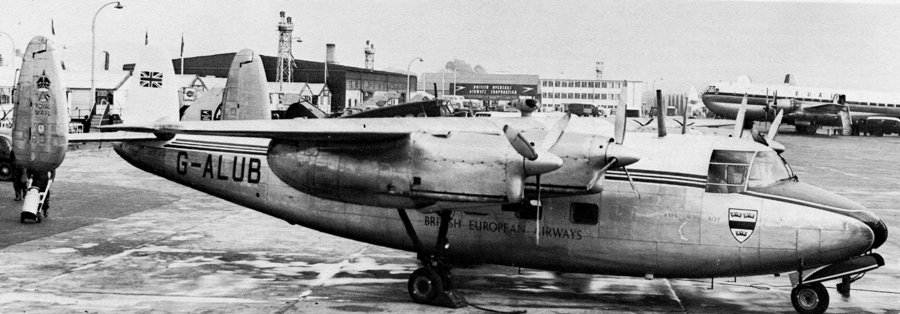
Sadly these trials confirmed the high operating costs that had been cause for concern for some years, especially compared to the de Havilland Heron being evaluated at the same time. It was therefore no great surprise when in February 1952 BEA cancelled the order completely. The DH Rapides would continue to serve these routes until an alternative type was found, an order that perhaps unsurprisingly went to the DH Heron.
The cancellation of the BEA order left the Ministry of Supply with a good number of Marathons with no obvious customer and this ultimately contributed to the adoption of the type for RAF service.
Fleet (all cancelled):
c/n 127 G-AMGW 'Clansman'
c/n 128 G-AMGX 'MacLeod'
c/n 129 G-AMHR 'MacDonald'
c/n 130 G-AMHS 'MacNeil'
c/n 133 G-AMHV 'MacGregor'
c/n 134 G-AMHW 'MacKenzie’
c/n 135 G-AMHX 'MacDuff'
Union of Burma Airways
First airline to place an order for the Marathon (but ultimately not the first to place the type into passenger service) was Rangoon-based Union of Burma Airways. In March 1952 the airline signed up for three aircraft, the final Marathons to be built, and they were delivered in July of the same year. The aircraft were fitted out in 18-seater configuration and featured an increased fuel capacity of 410 gallons, giving a range of 1,400 miles. The UBA aircraft were not fitted with reverse-pitch propellers, but a special ventilation system was installed for tropical climates, with the cabin heater omitted. The UBA Marathons were also configured for a radio operator as a third crew member.
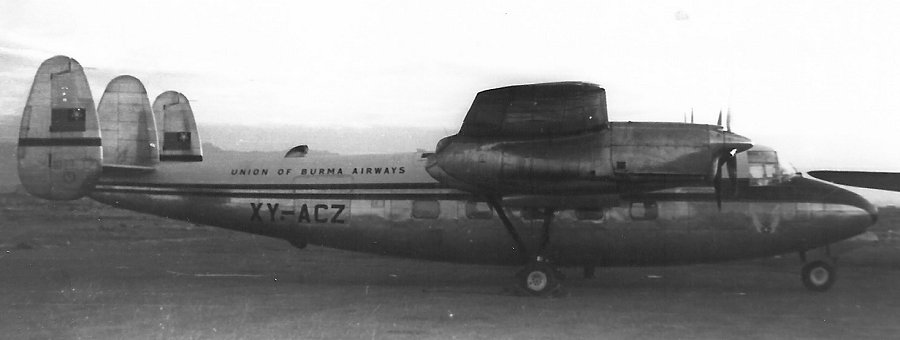
The Operations Department of UBA had a staff of 42, headed by the Chief Pilot. There were twelve pilots in total, plus 13 co-pilots and 13 radio operators. By 1952 the airline fleet comprised the three Marathons plus eight Dakotas, three DH Doves and two Airspeed Consuls.
At this time, Union of Burma Airways was operating mainly domestic services, but also flew an international service from Rangoon to Bangkok with DC-3 Dakotas. When the Marathons were delivered it was reported that they would expand the international network to India and Malaya as well as supplementing the DC-3s on the Thailand route. This was only partially correct and they in fact served mainly on routes from Rangoon to Penang in Malaya and to Mergui in southern Burma. The Marathon service would feature a stewardess, serving buffet meals.
On 4th August 1953, XY-ACX was lost in an accident after it overran the runway and caught fire on landing at Myaungmya in Burma. The 3-man crew and 18 passengers survived but the aircraft was destroyed.
It is thought that the UBA Marathons continued in service until early 1959, when the airline advertised the two remaining aircraft for sale, with spares. Airframe hours were listed as 957 and 806, “as is, where is”. The aircraft found no buyers and are assumed to have been scrapped in Burma.
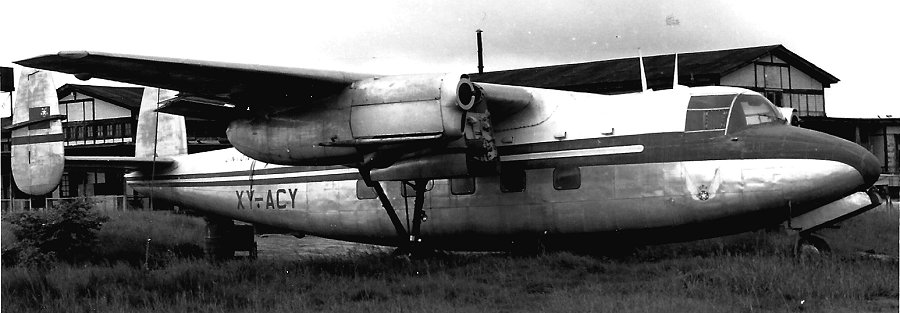
Fleet:
c/n 138 G-AMIA to UBA 09Jul52 as XY-ACX, w/o 04Aug53
c/n 139 G-AMIB to UBA 09Jul52 as XY-ACY
c/n 140 G-AMIC to UBA 09Jul52 as XY-ACZ
West African Airways Corporation
As far back as 1948, Nigeria-based West African Airways Corporation (WAAC) had ordered a fleet of six Marathons, but continued delays in their delivery led WAAC to purchase Bristol 170s to cater for its second-class services. In the meantime, Handley Page attempted to retain the airline’s interest in the type, and so one example (G-AMEO, the 12th production machine) was placed on loan to WAAC in 1951 for trials. The aircraft was handed over to WAAC chairman Sir Hubert Walker at Handley Page's Radlett plant, rather than Woodley as might be expected.
Fitted out in 18-seater configuration and painted in the WAAC livery of green and gold the Marathon performed a demonstration flight from Radlett on 14th March 1951 with the WAAC chairman and his wife, as well as other officials from the airline. The next day, G-AMEO (reregistered as VR-NAI upon arrival in Africa) was flown away to Lagos by WAAC’s chief pilot, Captain R Hallarn. Over the following three months the aircraft was given a thorough workout, flying 60,000 miles and logging 750,000 passenger miles. It was returned to Handley Page in August 1951.
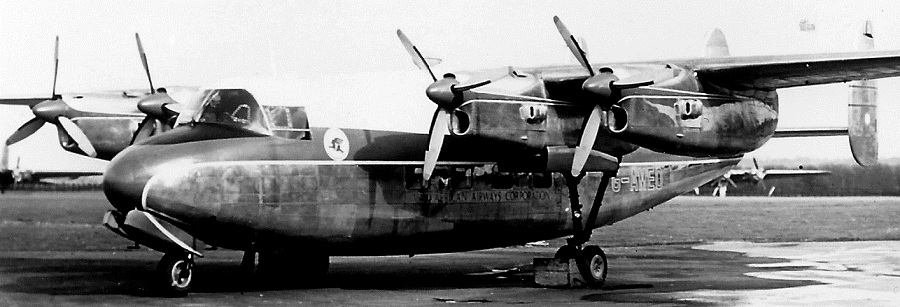
Following this trial, in July 1952 WAAC ordered six 18-seater Marathons for its 6,500-mile network of tropical routes in Nigeria, the Gold Coast and French West Africa. The Marathons supplemented an existing fleet of eleven de Havilland Doves, but were intended for a new first-class service. The WAAC Marathons had a 350 gallon fuel capacity and no provision for reversible propellers. Like the Burmese aircraft, they dispensed with cabin heaters in favour of a special ventilation system. The African Marathons operated with a crew of two - Captain and Second Officer/radio operator.
WAAC became the first airline operator to use the Marathon commercially when it inaugurated a service from Accra to Lagos on 1st November 1952. But after less than 18 months of service, from 1st April 1954 the six WAAC Marathons were withdrawn and offered for sale. By the end of 1953 it had become apparent that the type was not suitable for the airline; it had suffered a lot of unserviceability. But it was also the failure of the first-class service to expand, coupled with the rapid growth of second-class services that led WAAC to go for a single-fare system based only on Bristol 170s and Doves. Ultimately it was found that the Bristols were too big and the Doves too small, and the DH Heron would eventually prove to be the ideal aircraft for the airline.
Some idea of the minimal hours flown by the Marathons can be gauged from the records for c/n 127 (originally G-AMGW). This aircraft fist flew in 1951, with a total of 18 hours and 10 minutes in the logbook for the rest of that year. Following the cancellation of the BEA order it was placed into storage in 1952 and didn't fly at all that year (bear in mind that it had been sold to WAAC in September that year and obviously didn't get airborne until the following year). In 1953 - its only complete year of WAAC service - it flew 472 hours and 7 minutes. The following year it put just 141 hours and 5 minutes under its belt and in 1955 (by which time it was up for sale) a minimal 39 minutes.
The WAAC Marathons were ferried back to the UK and from January of 1955 had been advertised at £14,000 each by London-based WS Shackleton Ltd with airframe times ranging from 350 to 1,500 hours. They all found buyers.
Fleet:
c/n 112 G-AMEO to WAAC as VR-NAI 22Mar51 to 07Aug51. To HPR, MoS, to D-CFSA Aug55
c/n 127 G-AMGW to WAAC as VR-NAN 03Sep52, to Derby Aviation as G-AMGW 11Oct55
c/n 128 G-AMGX to WAAC as VR-NAO 26Sep52, to Balfour Marine G-AMGX as 28Apr55
c/n 129 G-AMHR to WAAC as VR-NAR 22Oct52, to Derby Aviation as G-AMHR 11Oct55
c/n 130 G-AMHS to WAAC as VR-NAS 14Nov52, to MoS (RAE) 21Feb55
c/n 133 G-AMHV to WAAC as VR-NAT 17Mar53, to MoS (RAE) 21Feb55
c/n 134 G-AMHW to WAAC as VR-NAU 08Jun53, to Jordan as VK501
Far East Air Lines
The first of two Marathons for Far East Air Lines (FEAL) was formally handed over by Sir Frederick Handley Page at Woodley, Reading, on 29th June 1954. FEAL was a start-up Japanese airline and majority held by the Handley Page agent in Japan, C Itoh & Co. The aircraft was accepted at Woodley by Admiral Todomi Nakamura, aviation manager of C Itoh. The aircraft were ordered to fulfil the airline’s route from Osaka to Fukuoka - a distance of about 290 miles, FEAL hoping to extend its network south to Okinawa during 1955. The first machine was G-AMHY, soon to be placed on the Japanese civil register as JA-6009. The second machine followed before the end of August 1954.
The FEAL Marathons were equipped to carry 20 passengers, with seats arranged in pairs - four pairs on the port side and six on the starboard side. The airline operated its Marathons with a crew of two pilots and a stewardess. Radio equipment was supplied by STR and consisted of ADF receiver, VHF transmitter-receiver, HF transmitter and HF receiver. The Japanese aircraft were finished in a colour scheme comprising a white upper fuselage with fuselage flashes in dark and light blue and the Japanese flag on the outer fins. The interior colour scheme was light blue and cream.
G-AMHY departed Blackbushe for Tokyo on 7th August 1954, the ferry flight being done by Airwork, Ltd, with a crew comprising Senior First Officer Riley and Radio Officer Rylands. The 10,000-mile flight was expected to take nine days and routed via Nice, Bari, Athens, Tripoli, Basra, Bahrain, Sharjah, Karachi, Delhi, Allahabad, Calcutta, Rangoon, Tourane, Hong Kong, Taipei, Okinawa and Iwakuni.
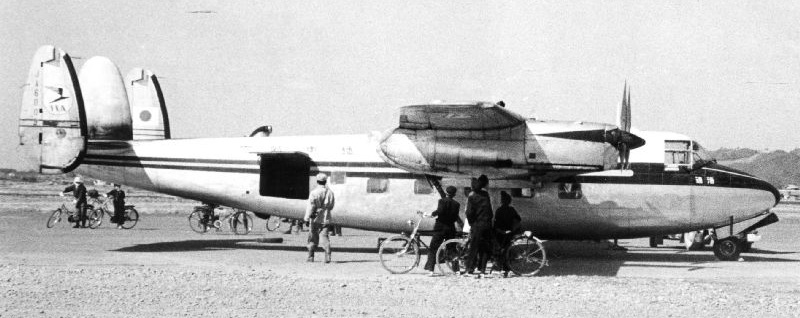
FEAL’s Marathons began operations from Itami on 15th November 1954. In October 1955, FEAL temporarily suspended Marathon operations after loose wing bolts were found during the periodic inspection of one of the aircraft. They both returned to service within the month. Other than a minor accident to JA-6009 on 17th March 1956 (the nose gear failed to lock on landing at Osaka International Airport, causing damage to the nose section), the FEAL Marathons saw incident-free service. In 1958 they were retired, shortly before FEAL became part of the newly-formed All Nippon Airways. Both Marathons were then stored at Osaka. JA-6009 was removed to become a display aircraft atop Nagoya Airport’s terminal building in September 1960, while the second Marathon, JA-6010, was for some time on display at the Tama-Tech amusement park near Tokyo. It has been reported that at least one of these aircraft survived until the early 1970s, at which point it would have been the last Marathon in the world.
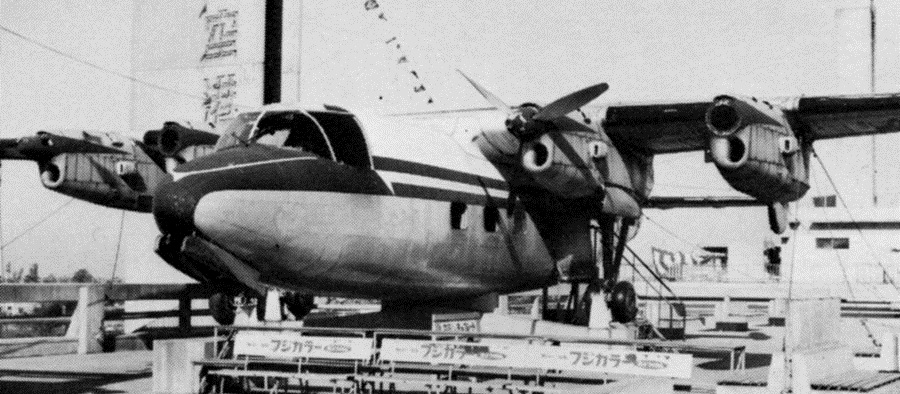
Fleet:
c/n 136 G-AMHY to FEAL 21Jul54 as JA-6009 ‘Naniwa’. WFU 1958 and registration deleted 11Oct60
c/n 137 G-AMHZ to FEAL 29Dec54 as JA-6010 ‘Heiwa’. WFU 1958 and registration deleted 24Dec64
Derby Aviation (Derby Airways from 1959)
Formed at Burnaston airport near Derby in 1946, Derby Aviation Ltd initially undertook flight training, but from 1953 this operation ceased, concurrent with the award of a 6-year licence to operate scheduled flights from Burnaston via Wolverhampton to Jersey. The first flight was made on 18th July 1953 by a de Havilland Dragon Rapide but from 1955, the company bought its first Douglas Dakota, a 36-seater which also flew on the Jersey route. These flights usually cleared customs at Bournemouth (Hurn).
In October of the same year, two ex- West African Airways Corporation Marathons (c/n 127 G-AMGW (ex-VR-NAN) and c/n 129 G-AMHR (ex-VR-NAR)) were also purchased. In common with the airline’s practice of naming its aircraft, G-AMGW was christened ‘Millersdale’ and G-AMHR ‘Monsaldale’, after dales in the Derbyshire Peak District. Derby Aviation converted the aircraft from 18-seat to 20-seat configuration and completed the Certificate of Airworthiness renewals in its Burnaston hangars.
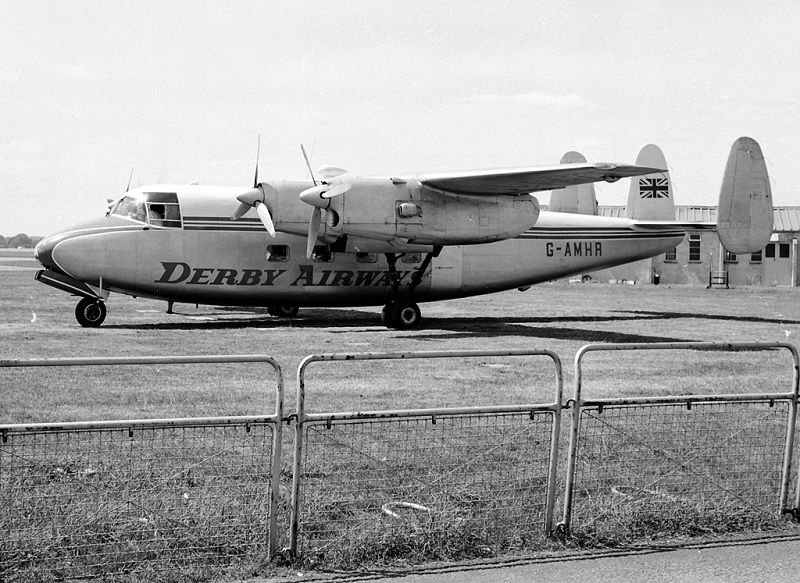
The Marathons were purchased to serve new short-haul services on both charter and scheduled work. For 1956 the airline started three new routes: Derby - Blackpool (fuel stop) - Isle of Man, Derby – Elstree (fuel stop) - Isle of Wight and Derby - Birmingham (customs) – Ostend, and the new machines were primarily aimed at these new destinations. On occasion the aircraft also operated on the Jersey route, but in these cases the aircraft operated with just 18 seats.
The Derby Aviation Marathons proved to be the only examples of their type to be used by a British airline and were approved for operation at weights up to 18,250 lb (8278 kg). They were able to operate from runways as short as 750 yards (685 m) in length and this enabled them to operate from minor airfields such as those found in the Isle of Wight.
During this period growth was rapid: the Dragon Rapides were removed from service and a second Dakota added. In 1955 Derby Aviation carried 6,200 passengers and in the following year that had more than doubled, to 12,560. For 1957 the airline added a Derby – Glasgow service and also began inclusive tour services from Birmingham and Blackbushe. This coincided with the arrival of a third Marathon – G-AMEW, an ex-RAF machine that had been purchased from the Ministry of Supply, having been de-converted from trainer configuration and placed on loan to HPR. It was collected from Woodley by Derby Aviation on 28th August 1957 and flown to Burnaston. It was named ‘Matlockdale’.
At this time, Derby Aviation operated a flying school at Elstree and students taking their Civil Pilots Licence would, as soon as they had obtained their R/T licence, fly as pilot's assistant in a Marathon on the Derby - Glasgow run. This route was usually a one-crew operation, and so the pupil pilot was able to take advantage of the vacant right-hand seat.
In 1958, the company formed Derby Aerosurveys, Ltd at Elstree Aerodrome, Herts and performed geophysical survey work throughout Britain using Anson aircraft. The new offshoot was supported by Canadian Aero Service Ltd, which had expertise for this type of work. Derby Aerosurveys was mainly engaged in oblique photography, and it claimed that the Dakotas and Marathons of Derby Aviation could also be utilised for this mission if required.
Major fleet expansion began in 1958 with the acquisition of a third DC-3 and two more the following year. This enabled Derby Aviation to apply for a seven-year license for services from Cardiff - Bristol – Ostend, initially for three return flights per week, rising to seven return flights per week and running from Mav to September. A second seven-year licence was granted on the route Luton - Derby – Manchester – Dublin, seven return flights per week with Dakota aircraft and 14 return flights per week with Marathons. Services to both were scheduled to begin from 1st July 1959. Further applications were filed for concessions running Derby - Birmingham - Amsterdam (daily) and a specific Dakota route from Birmingham – Cardiff/Bristol – Bournemouth (customs) - Bilbao (weekly, rising to three per week). Other Marathon/Dakota applications were granted for daily departures from Cardiff and/or Bristol – Derby and flights to the Channel Islands were increased to cover the period when BEA terminated its summer operations at the end of each season. Brussels, Exeter, Newquay, Carlisle and Edinburgh were also added as destinations and all could be covered by either Marathon or Dakota aircraft.
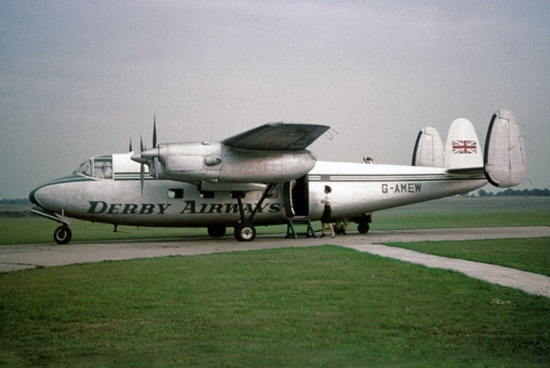
As late as October 1960, when Derby Airways submitted Application No. 143/13 for permission to operate a number of existing services until 30th September, 1966 via a new stop at Cambridge, the Marathon was still included. However 1960 was the aircraft’s final season with Derby Airways, and subsequently the airline expanded further to a fleet of eight DC-3s. The final Derby Airways Marathon service was completed on 26th September 1960, routing from Derby to Dublin and back, then on to Luton and return.
In October 1964 the company changed its name to British Midland Airways and went on to bigger things.
Fleet:
c/n 118 G-AMEW ‘Matlockdale’ (XA265) MoS, to Derby Aviation 28Aug57. Destroyed 17Feb64 but fuselage section to Berkshire Aviation Museum, Woodley
c/n 127 G-AMGW ‘Millersdale’, to Derby Aviation 11Oct55. Destroyed 17Feb64
c/n 129 G-AMHR ‘Monsaldale’, to Derby Aviation 11Oct55. Destroyed 17Feb64
One aircraft purchased for spares/scrap:
c/n 115 G-AMET (XA262), to Derby Aviation 16May59. Permanently WFU 23Oct59
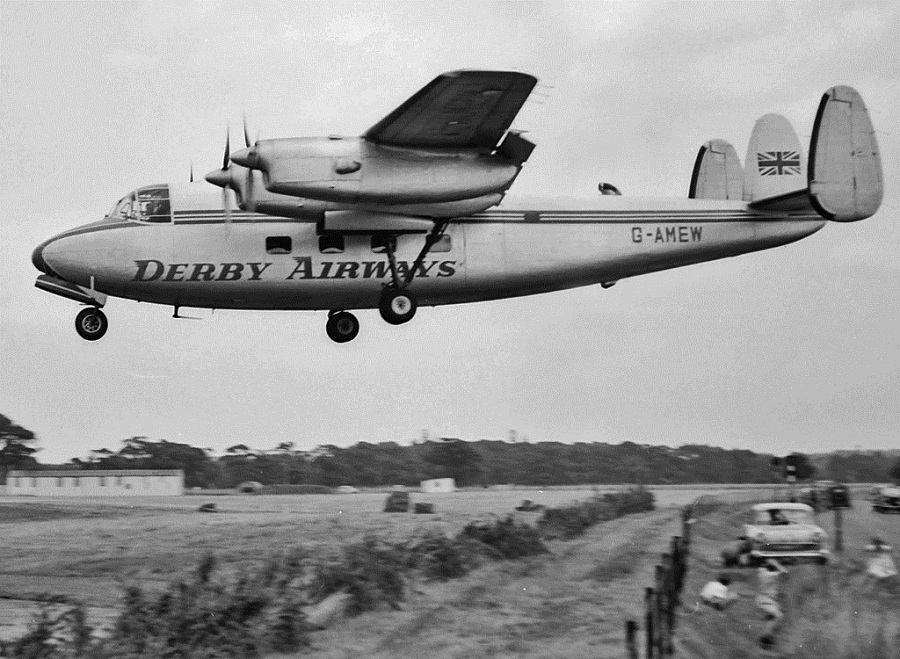
Air Navigation & Trading Co Ltd
On 25th August 1958, Air Navigation and Trading Company of Blackpool purchased the two RAE Marathons (XJ830 and XJ831) from the Ministry of Supply. These aircraft reverted to their civilian registrations (G-AMHS and G-AMHV, respectively) on 18th September. G-AMHV was despatched from Farnborough to Blackpool’s Squires Gate airport on 2nd October, followed by ‘MHS four days later.
Air Navigation & Trading Co Ltd had been established in 1946 and operated a mixed fleet of aircraft on general and contract charter flying, pilot training and aeronautical engineering. Illustrating the company’s diverse operations, by 1958 its fleet comprised an Avro 19, three DH Rapides, two DH Dragons, a DH Drover, two DHC Chipmunks and a Percival Pembroke.
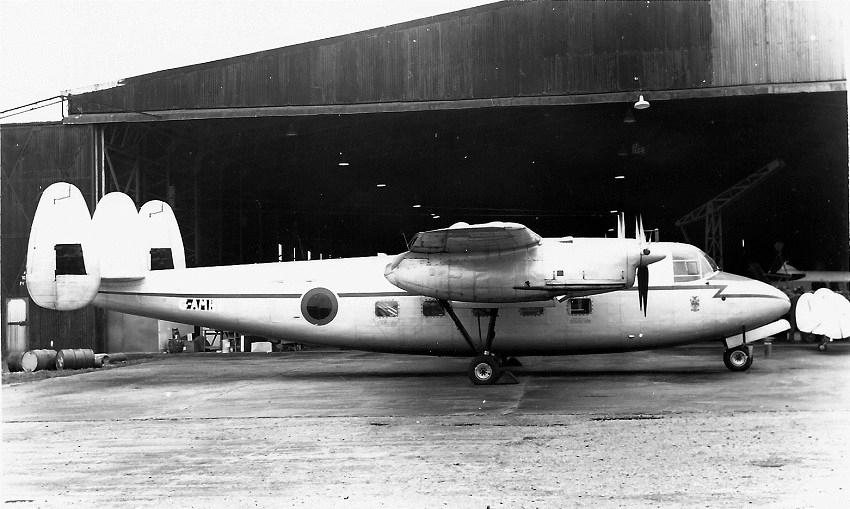

c/n 130 G-AMHS to AN&TC 25Aug58. To Airwork Services Ltd, Bournemouth 08Nov61
c/n 133 G-AMHV to AN&TC 25Aug58, “to Canada” 11Mar61 but b/u Wymeswold 1963 (pwfu 27Oct64)
Balfour Marine Engineering Co Ltd
In the early 1950s, Samuel Norman of the Ilford-based Balfour Marine Engineering Company reached an agreement with the American AMi manufacturer, to build its jukeboxes under licence. The UK-built machines would be known as “BAL-AMi” jukeboxes and they would be built in Ilford. To help market these machines, Balfour bought a single Marathon (G-AMGX), which was registered to the company in April 1955. It was then fitted it out as the “BAL-AMi Ambassador” flying showroom. The aircraft was used to provide mobile displays throughout the UK.
At the centre of the Balfour empire was its playboy owner, Sam Norman. Born in Ilford in 1915, Norman had inherited the managing directorship of Balfour Marine upon his father's death and soon began expanding what was initially a component manufacturing concern into a company that would enable him to claim the title, “The Jukebox King of Europe”, just at a time when rock’n’roll music opened this market for exploitation. He was soon able to set up a second factory at Le Touquet and owned an extensive property in Chigwell, along with a gold-painted Bentley Continental and a green Ferrari to go with it.
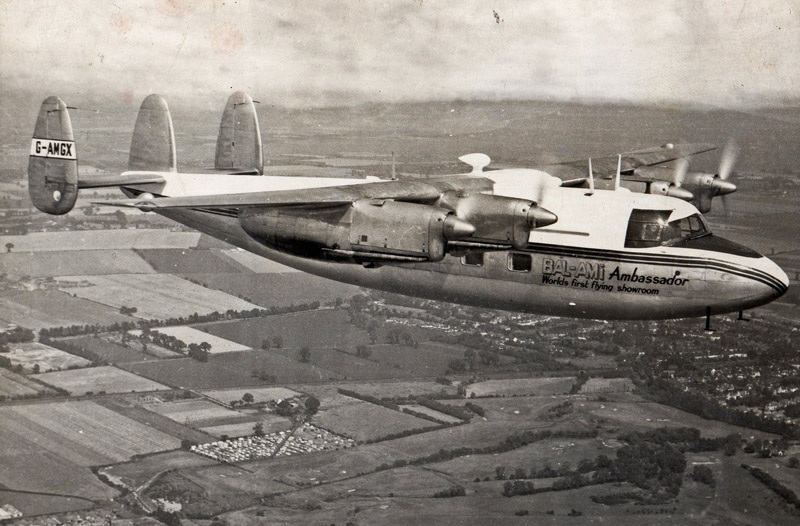
Sam Norman also learned to fly and owned his own Miles Gemini, which was based at Southend airport, along with his newly-acquired Marathon. Flight magazine during August 1955 informed readers that the aircraft was “…now being prepared for a tour of North America”. It departed Heathrow on 18th August bound for Canada and the USA, but it seems those plans came to naught. Departing on the proposed tour, it was found that the installation of the jukeboxes had reduced fuel capacity to such an extent that the aircraft was now unable to fly the leg from Scotland to Iceland, and so it turned back to Southend.
The aircraft does seem to have been used throughout the United Kingdom for its intended purpose, but it had a short career and operated only from May 1955 until August 1956, when its Certificate of Airworthiness expired.
The Marathon was subsequently stored at Southend and was seen there, engineless, in 1960. It was scrapped circa 1962.

Fleet:
c/n 128 G-AMGX to Balfour Marine Engineering Co Ltd 28Apr55. PWFU 28Nov62 at Southend
FG Miles Limited
Following the receivership of Miles Aircraft Limited, in 1949 Frederick Miles formed at new company, FG Miles Limited at Shoreham. The new organization then undertook a number of aircraft projects such as the M.100 Student jet trainer and a joint venture with Hurel Dubois on the HDM.105 light transport prototype. Miles also formed a number of offshoot companies, including Meridian Airmaps Ltd, Miles Development Products Ltd, Miles Electronics Ltd and Miles Plastics Ltd.
Therefore it came as no surprise when in March 1957, FG Miles Ltd applied to the Air Transport Advisory Council for a permit to operate summer season scheduled passenger services. The application was for the operation of DH Herons and HPR Marathons on the Shoreham – Dieppe run, to begin in 1957. Other summer services were included in the application, including Shoreham - Le Touquet, Shoreham – Guernsey – Jersey and Shoreham - Paris. However at this time, FG Miles possessed neither Heron or Marathon aircraft and no further action was taken in this respect.
Nevertheless, in December 1958, when RAF Marathons came up for disposal, FG Miles bought two aircraft (G-ALVY, ex-XA252 and G-AMHT, ex-XA274) from 10 MU storage at Hullavington. They were flown to Shoreham, still wearing their RAF colours and with hastily-applied civil registrations. Two further Marathons (G-AMER, ex-XA261 and G-AMGR, ex-XA269) followed in May of 1959.
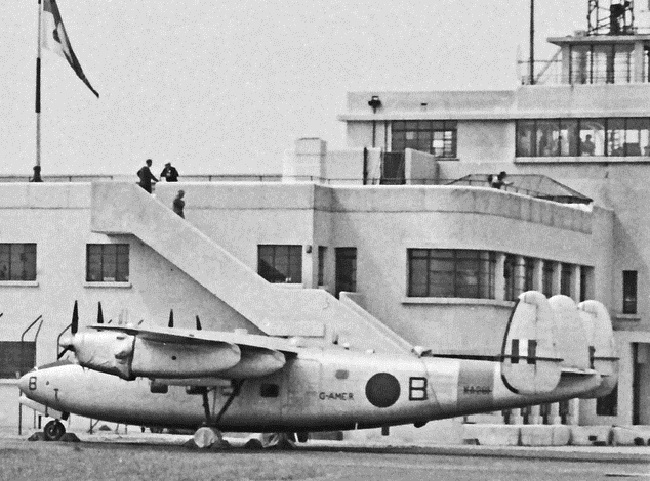
Though supposedly purchased for scrap, it is obvious that Miles sought to sell at least some of these aircraft on the civil market, and work commenced to convert G-AMHT into a 20-seat passenger aircraft. In September 1962 the aircraft was advertised for sale and described as, “Completed to C of A standard with all current mods. Only 280 hours since new and backed by comprehensive supply of spares. Cabin layout for 18 or 20 passengers.” G-AMHT was advertised at £5,500 but did not sell. It remained at Shoreham and was scrapped there circa 1964.
The other three FG Miles Marathons had been scrapped in 1962, presumably contributing to the “comprehensive supply of spares” later to be offered with G-AMHT.
Fleet:
c/n 104 G-ALVY (XA252) 10 MU, to FG Miles Ltd 31Dec58. Scrapped 07Mar62
c/n 114 G-AMER (XA261) 10 MU, to FG Miles Ltd 11May59. Scrapped 07Mar62
c/n 122 G-AMGR (XA269) 10 MU, to FG Miles Ltd 27May59. Scrapped 07Mar62
c/n 131 G-AMHT (XA274) 10 MU, to FG Miles Ltd Dec58. Permanently WFU 23May64

Mess-und Verksstelle, Germany
Following its loan to West African Airways Corporation in early 1951, G-AMEO had returned to the UK and from 7th August 1951 became the property of Handley Page (Reading) Limited. It is likely that in line with many other Marathons it was stored at Blackbushe during this period, pending conversion for the RAF. In line with this it was transferred to Ministry of Supply in November 1951, but instead of being converted to a T.11 trainer the Marathon was returned to HPR ownership in July 1953 pending a sale.

In 1954 the German government applied for the purchase of aircraft for the calibration of airport radio and radar equipment. As a result contracts were agreed with Handley Page and de Havilland to acquire one example each of Marathon and Dove types for this role. The Marathon, c/n 112, arrived in Germany during January 1955, still carrying its British registration G-AMEO. Its flight crew and maintenance technicians consisted of British citizens until 1st April 1955, when the Federal Republic regained control over its air space. After this point the flight crew was replaced with German personnel. Maintenance of the aircraft was still done by British engineers until the end of the 1960s, via a servicing contract with British United Airways.
With the regaining of its airspace, Germany had set up a dedicated flight calibration unit of the Bundesanstalt für Flugsicherung (BFS, or federal institution for air traffic control), based in Frankfurt. The new unit was known as the Mess-und Verksstelle (Calibration and Test Unit - MVS) and initially operated the Dove and Marathon, but later other types were added to its fleet. On 11th June 1955 G-AMEO was placed on the German register and became D-CFSA. For the next few years it undertook radio calibration work.
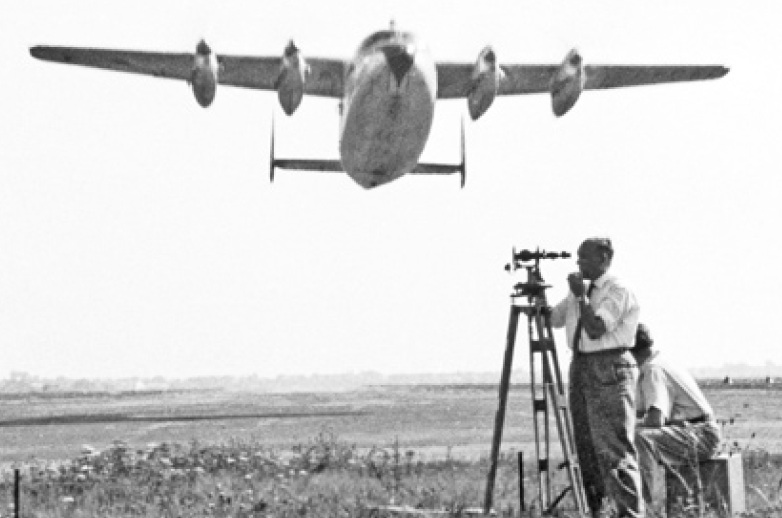
At Frankfurt, the unit was located in a building close to what is nowadays Terminal 2. In the early days, flight inspection equipment was not commercially available and so the MVS had its own development department to design the measuring and calibration equipment, using commercially available components and adapting them for flight inspection purposes.
The Marathon was grounded in January 1962 due to increasing technical issues, but two further De Havilland Doves were purchased in 1962 and 1963 to increase the fleet to three aircraft.
Fleet:
c/n 112 G-AMEO, to BFS/MVS, Frankfurt as D-CFSA .55, wfu Jan62
Jordan
During 1954, an ex-West African Airways Corporation Marathon, VR-NAU (c/n 134) was purchased by the Royal Jordanian Air Force (RJAF) for use as a VIP transport. VR-NAU was transferred to Eagle Aviation at Blackbushe and then converted into a VIP configuration and the RJAF serial number VK501 was applied. Conversion was completed at the end of 1954 and in November the aircraft was delivered to Jordan.
Sadly the aircraft did not survive for long; it was damaged beyond repair in an unspecified incident the year after it was delivered.
The RJAF soon replaced the Marathon with a VIP Vickers Varsity, which was also converted by Eagle Aviation, and also given the serial number VK501.
Fleet:
c/n 134 VR-NAU/G-AMHW, to RJAF Nov54 as VK501. DBR 1955
